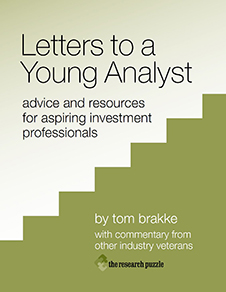
- Wednesday, May 13th, 2009
- not always comparable
-
When first looking at a piece of academic research, it’s important to assess whether the analysis being performed approaches the problem as an investment practitioner would. It took me a fair bit of time to see that I was going to illustrate that lesson right up front in this series by misunderstanding the purpose of the paper I intended to review, “Optimal Equity Valuation Using Multiples: The Number of Comparable Firms,” by Ian Cooper and Leonardo Cordeiro of the London Business School.SSRN | The version I read was posted on SSRN in September of 2008.
In selecting the paper, I was searching for insight into the process of valuation and the common use of “comparables” by investment decision makers. I favor using a “map” of valuation measures in a way that recognizes that there are many approaches: some popular and some used infrequently, some incredibly labor intensive and others that can be calculated quickly using grade school math, some theoretically “pure” and a few easily challenged as nonsensical. They all are worth tracking, either for their inherent worth or because it is helpful to know how other market participants assess value. Thus a map of them all can guide the journey of valuation.
I expected the paper to give me some ideas on techniques for determining the best comparables to use — what ones and how many. So I was reading along when I realized that the problem had been defined differently by the authors than the one I had in my head. I think the disconnect is best summarized in the introduction for another paper on the topic, which says, “Given our efficient markets framework, our focus is on explaining current prices, not on the ability of multiples to identify mispriced stocks.”SSRN | The quote is from “Equity Valuation Using Multiples,” a 2000 paper by Jing Liu of UCLA and Doron Nissim and Jacob Thomas of Columbia. Whoops; I’m after the latter.
Nevertheless, the nature of comparability and the process of applying it warrant more attention than they are typically given. The number of comparables used by practitioners is often close to the handful that the authors cite as reasonable for their purpose, but those analysts are looking for inefficiency, not efficiency, so I’m not sure it matters that there is some similarity. In practice, the list of comps used can vary significantly for a given stock, and it’s often unclear whether there’s any rhyme, reason, or intellectual rigor to the particular method that has been chosen. (For a demonstration of the variability, look at the firms chosen as comparable to a given stock in research reports produced by ten different fundamental and quantitative research providers.) At a minimum, documentation of the approach taken by an analyst should be better than it usually is, something that is not often said about an academic study. Practitioners could benefit from the kind of thorough explanation and vetting of assumptions that occurs regularly in discussions of academic work.
The paper is a concrete example of the clash of belief systems that occurs in the market every day. It uses the long-term forecast of a firm’s growth rate as central to the determination of the best group of comparable firms to assess the efficiency of today’s price. I don’t doubt that to be a valid conclusionAt least in relatively stable market environments. It will be interesting to see an updated version of the paper that includes the last couple of years of attitude readjustments and the accompanying fluctuations in growth rates. given the popularity of PEG ratios with many market participants. But when I look at those estimates of growth, I see the seeds of inefficiency and opportunity, since I believe that they aren’t very good predictions of the future in general.
My experience tells me that the creators of those growth rates spend relatively little time thinking about them in concrete ways and that the estimates take on a life of their own.the research puzzle | Here’s an earlier piece that includes some commentary on the story of Cisco in that regard. For awhile, they can be self-fulfilling prophesies, as corporate managers advertise and then try to manage to a growth rate that is adopted by the community of analysts. In the end, however, many of the biggest losses for investors come when a stock that was efficiently priced to the growth rate is forced to reflect the reality that it was unsustainable.
So, I got something different than I expected out of this particular foray into the realm of academe, but it helped me to see a part of a puzzle that is central to investing. We’ll explore other research of interest — and maybe will find other benefits — in upcoming installments.
